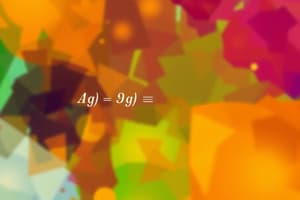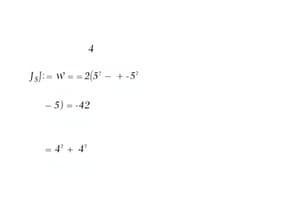Podcast
Questions and Answers
What is a group of cells with similar structures and functions called?
What is a group of cells with similar structures and functions called?
- Cell
- Tissue (correct)
- Organ
- Organ system
What is the term for an organism made of many cells?
What is the term for an organism made of many cells?
- Unicellular
- Eukaryotic
- Multicellular (correct)
- Prokaryotic
Which of the following describes an organ?
Which of the following describes an organ?
- A single cell
- A collection of tissues performing a specific function (correct)
- A group of similar cells
- A system of multiple organisms
What term defines the level of detail you can see with a microscope?
What term defines the level of detail you can see with a microscope?
What is the purpose of magnification in microscopy?
What is the purpose of magnification in microscopy?
Which type of microscope is best for viewing the smallest sub-cellular structures?
Which type of microscope is best for viewing the smallest sub-cellular structures?
What unit of measurement is one millionth of a metre?
What unit of measurement is one millionth of a metre?
What is a collection of organs working together called?
What is a collection of organs working together called?
What term best describes an organism that has many organ systems contributing to its survival?
What term best describes an organism that has many organ systems contributing to its survival?
Which of the following defines a specialised cell?
Which of the following defines a specialised cell?
To calculate the magnification, one must divide the image by the:
To calculate the magnification, one must divide the image by the:
A centimetre is one what of a metre?
A centimetre is one what of a metre?
In the equation for calculating the magnification, what must have the same unit?
In the equation for calculating the magnification, what must have the same unit?
Which of the following is not a shared attribute of the cell membrane and the cell wall?
Which of the following is not a shared attribute of the cell membrane and the cell wall?
Pholem in plants form a ______.
Pholem in plants form a ______.
Flashcards
Cell
Cell
The basic unit of all forms of life.
Eukaryotic Cells
Eukaryotic Cells
Cells with genetic material enclosed in a nucleus.
Prokaryotic Cells
Prokaryotic Cells
Bacterial cells; these don't have a nucleus to enclose their genetic material.
Cytoplasm
Cytoplasm
Signup and view all the flashcards
Mitochondria
Mitochondria
Signup and view all the flashcards
Ribosome
Ribosome
Signup and view all the flashcards
Chloroplast
Chloroplast
Signup and view all the flashcards
DNA
DNA
Signup and view all the flashcards
Unicellular
Unicellular
Signup and view all the flashcards
Multicellular
Multicellular
Signup and view all the flashcards
Tissue
Tissue
Signup and view all the flashcards
Organ
Organ
Signup and view all the flashcards
Small intestine
Small intestine
Signup and view all the flashcards
Ventilation
Ventilation
Signup and view all the flashcards
Diffusion
Diffusion
Signup and view all the flashcards
Study Notes
- These notes cover the essentials of vector-valued functions of a real variable
Definition
- A vector-valued function maps a real number to a vector in $\mathbb{R}^n$.
- It is expressed as $\overrightarrow{r}(t) = (f_1(t), f_2(t),..., f_n(t))$, where each $f_i(t)$ is a real-valued function.
Example
- $\overrightarrow{r}(t) = (cos(t), sin(t), t)$ is a vector-valued function from $\mathbb{R}$ to $\mathbb{R}^3$.
- Its component functions are $f_1(t) = cos(t)$, $f_2(t) = sin(t)$, and $f_3(t) = t$.
Graphical Representation
- Vector-valued functions are graphed as curves in $\mathbb{R}^n$.
Limit
- The limit of $\overrightarrow{r}(t)$ as $t$ approaches $a$ is found by taking the limit of each component function:
- $\lim_{t \to a} \overrightarrow{r}(t) = (\lim_{t \to a} f_1(t), \lim_{t \to a} f_2(t),..., \lim_{t \to a} f_n(t))$ if the individual limits exist.
Continuity
- $\overrightarrow{r}(t)$ is continuous at $t = a$ if:
- $\overrightarrow{r}(a)$ is defined.
- $\lim_{t \to a} \overrightarrow{r}(t)$ exists.
- $\lim_{t \to a} \overrightarrow{r}(t) = \overrightarrow{r}(a)$.
- Equivalently, $\overrightarrow{r}(t)$ is continuous at $t = a$ if all its component functions are continuous at $t = a$.
Derivative
- The derivative of $\overrightarrow{r}(t)$ is defined as:
- $\overrightarrow{r}'(t) = \lim_{h \to 0} \frac{\overrightarrow{r}(t+h) - \overrightarrow{r}(t)}{h}$, if the limit exists.
- If $\overrightarrow{r}(t) = (f_1(t), f_2(t),..., f_n(t))$, then $\overrightarrow{r}'(t) = (f_1'(t), f_2'(t),..., f_n'(t))$.
Geometric Interpretation of the Derivative
- $\overrightarrow{r}'(t)$ is a tangent vector to the curve at the point $\overrightarrow{r}(t)$.
Integral
- The integral of $\overrightarrow{r}(t)$ is found by integrating each component function separately:
- $\int \overrightarrow{r}(t) dt = (\int f_1(t) dt, \int f_2(t) dt,..., \int f_n(t) dt)$
Arc Length
- The arc length $L$ of the curve from $t = a$ to $t = b$ is:
- $L = \int_a^b ||\overrightarrow{r}'(t)|| dt$, where $||\overrightarrow{r}'(t)||$ is the magnitude of the derivative vector.
Studying That Suits You
Use AI to generate personalized quizzes and flashcards to suit your learning preferences.




